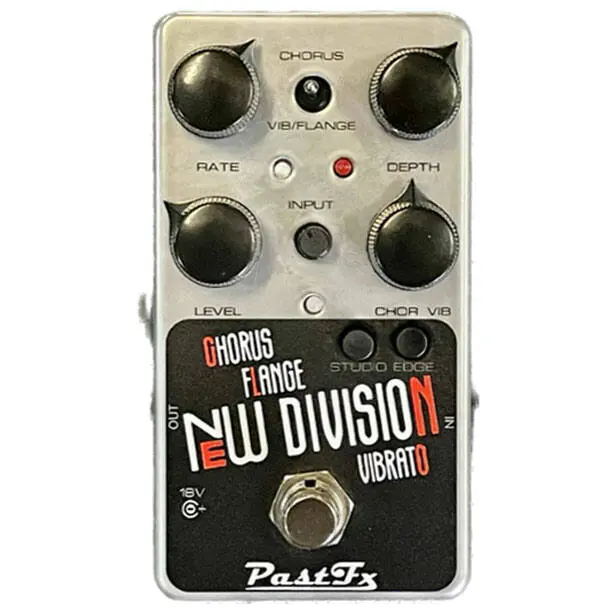
Like all the other stompboxes by the Australian builder, the PastFX New Division is heavily inspired by a classic circuit (in this case two early version of the EHX Clone Theory, famously used by Joy Division’s basssist Peter Hook) but updated with useful features not found in the original.
The New Division is a faithful recreation of the 1970’s / 80’s MN3007 EHX pedal that also incorporates both the Edge switch found in the 1970’s Sad1024 version of it and the Vib/Flange switch, which replaced it in the MN3007 version. Unlike the original, it operates at 18v for increased headroom and lower noise floor
It features the three knobs found on all the Clone Theory pedals, Rate, Depth and Chor/Vib, which gradually removes the dry signal from the effect, delivering chorus when fully turned to the left, vibrato when fully turned to the right, and a combination of the two for any setting in between.
There are also two new knobs not found in the original, and they are both gain ones: a mini Input control, placed between the two larger bottom knobs, sets the amount of signal going in the circuit, while the Level knob allows to compensate for any signal loss when the effect is on, which was a problem in the original units.
Next to the already mentioned Edge switch, which brightens the tone, the company added an entirely new Studio switch, which engages a compander circuit allowing to further reduce the effect’s floor noise, bringing it to studio-grade standards.
On top of it all, an internal 70’s/80’s slide switch adds tone filtering to simulate the voicing of the MN3007 (80’s) and SAD1024 (70’s) versions of the Clone Theory, with the latter sounding a little darker and heavier on the mids.
This pedal seems like a serious contender for anyone looking for a quality chorus with vintage voicing. We added it to our article about the best chorus pedals.
PastFX New Division, Builder’s Notes
The PastFx New Division Is a faithful recreation of the 1970’s / 80’s MN3007 EHX Clone Theory. We have also incorporated some of the features of the 1st 1970’s Reticon Sad1024 version, while adding new options that address some of the flaws of the original circuit.
Peter Hook (New Order /Joy Division) is probably the most well-known artist associated with these early models. The 1970’s Sad1024 version incorporates an “Edge” (Bright switch), however when the Bucket Brigade chip was replaced with the MN3007, the bright switch was removed and a VIB/Flange switch was added.
The Heart of the New Division is its Chorus effect.
Exclusive to the New Division is a “Studio” switch, which engages a compander circuit allowing to further reduce the floor noise of the effect. (Studio switch is designed for the Chorus mode only) One of the complaints of the early Clone Theory pedals is that they were quite noisy.
When in Chorus toggle mode, the Chorus /Vibe control is active. As the knob is turned clockwise the effect begins to reduce the dry signal, until a full Vibrato effect is heard.In VIB/Flange mode, the CHOR VIB control is bypassed and inverted feedback is added.
Operates off 18VDC and does not have any internal voltage doubler circuit. This help keep floor noise to a minimum.
Also unique to the New Division is an internal 70’s/80’s slide switch. This allows the subtle tone filtering options of the two early MN3007 (80’s) /SAD1024 (70’s) version. The 70’s has slightly more mids and is a tad darker in high frequencies.
Current draw 150mA
Features of the New Division
- True Bypass
- Uses NOS Panasonic MN3007 BBD
- Includes “Edge” switch from 1970’s version
- VIB/Flange switch
- Effect and Dry outputs
- Peak Level Red Led indicator
- Red (VIB/Flange) – Blue (Chorus ) Dual Led LFO rate indicator
- New Input and Output Level controls address the volume drop found on the original Clone Theory. This also allows signal level adjustments to prevent clipping on various types of guitars/bass guitars.
- (Starting place is to turn input control up just before the Red LED begins to clip/light up then bring up the level control to achieve unity gain with bypass signal).






















